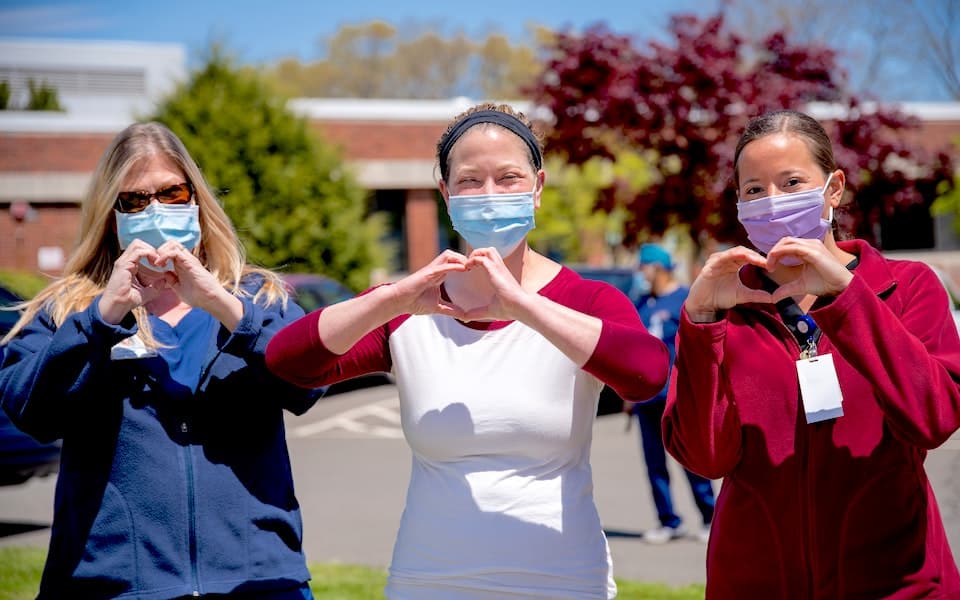Guam Becomes First U.S. Territory to Join Nurse Licensure Compact (NLC)

It just got easier for travel nurses to work in the Pacific! Guam has officially become the first U.S. territory to join the Nurse Licensure Compact (NLC). The state’s Governor Lourdes “Lou” Leon Guerrero signed the new bill into effect March 5, 2021. “Today, Guam joins a growing number of states stepping into the future of nurse licensure,” said Sen. Mary Camacho Torres in a press release by NCSBN. “With the enactment of the NLC, nurses from other member states can now come here and practice immediately, increasing our people’s access to safe, quality care without the need to apply and wait for a Guam nursing license or disaster declaration.” The new bill to enact Guam into the NLC didn’t come without debate and opposition. For example reported by The Guam Daily Post, some worried that the bill would cause current nurses practicing on the island to leave to higher paying positions, leaving the Guam healthcare systems even more short staffed. But during a public hearing held in February 2021, supporters defended joining the NLC with personal testimonies. Additionally a survey from The Guam Board of Nurse Examiners found that 98 percent of nurses who responded supported joining the NCL. Guam’s entry into the NLC allows nurses holding any active compact nursing license to practice in Guam to assist with the nursing shortage. Residents of Guam will not be able to obtain a multistate license until the NLC is fully implemented in 2022. Why Guam? If you didn’t know, Guam is an organized unincorporated territory of the U.S. located in the Western Pacific Ocean that spans 210 square miles. In 2019, the island had an estimated population of around 167,300 and saw more than 1 million vacationers per year. The tropical rainforest climate also brings a steady 75 to 85 degrees year-round. Filled with rich culture, history and cuisine, Guam’s island lifestyle offers healthcare travelers a ton to do outside of the hospital. Visit The Guam Guide to discover popular attractions, beaches and more.
Travel Nursing & Allied Pay Packages Stabilizing to Pre-COVID Levels

The travel nursing and allied health job market is facing another dramatic shift as we enter a new stage of the pandemic. The number of healthcare travel jobs is steadily decreasing each week and as you may have noticed, pay rates are dropping. Here’s why and recommendations for getting the highest pay packages. Where did the crisis jobs go? More people are getting vaccinated daily and COVID cases and hospitalizations are decreasing. Good news! Therefore, hospitals’ patient census across the country is returning to normal levels and there is less demand for crisis jobs. “We’ve seen a decrease in both the number of jobs and pay rates from healthcare facilities across the country,” said Jennifer Pomietlo, VP of Business Development at StaffDNA. “But it’s not because they don’t need healthcare travelers anymore, they’re just returning to non-crisis rates.” In January’s peak, there were more than 30,000 travel nursing openings nationwide, but as of March 2021 that number has fallen to approximately 8,000. The once $6,000 to $10,000 weekly pay packages are gone. So what does the average traveler’s pay package look like now? According to StaffDNA, pay rates for travelers have decreased 25% on average since vaccinations began—depending on the location and specialty. Lock in Pay Rates Now In 2019 pre-COVID, average pay packages for travel nurses were around $1,800 to $2,000 per week. Today, StaffDNA has assignments averaging $3,000 per week and up to $4,400 per week, but rates may continue to drop so we recommend travelers lock in their assignments now—whether it’s by extending your current assignment or finding a new assignment at a facility that is still offering higher rates. Higher Competition Last year, many healthcare professionals left their permanent positions to travel to communities in need and take advantage of the high paying crisis jobs. With more travelers means nurses and allied health professionals are facing more competition for desired positions. When ICU bed capacity was strained, facilities were being more relaxed with travelers’ experience level, but that’s no longer the case. “High-paying assignments are still out there,” Pomietlo added, “There are just not as many and there’s a lot more competition.” While the travel nursing and allied market is still fluid, licensing requirements are changing too and can vary by state and facility. Click here for compilation of the most updated state-by-state licensure information. Is Your Profile Ready? Within an hour of a new job opening, there could be more than 20 qualified submittals. It’s important for travelers to keep your profile and compliance up-to-date so that you’re ready to submit right when a job you want opens up. Keep up with the highest-paying nursing and allied health jobs in real-time on StaffDNA’s mobile app or online Job Board—no registration required.
Where Can Travel Nurses Find Short Term Housing

By Alex McCoy, Contributing Writer, Owner of Fit Travel Life When I tell people I work in the travel nursing industry, the number one question I get asked is “What do you do for housing?”. Everyone seems to assume that I either live in a hotel most of the year or that I have to rent an empty apartment at a crazy high price. I am here to assure you–neither of these things are true. The travel nurse rental market has a niche of its own, and with the rising interest in short-term, furnished rentals, many companies have stepped up to make sure you can find quality housing for your assignments without spending a fortune. Here are a few of my favorite places to find short-term housing. Furnished Finder Furnished Finder and its sister site–TravelNurseHousing.com focus solely on stays of 30 days or longer. And all of the landlords are encouraged to keep on-brand with the name of the site and provide furnishings as well. In addition, the sites are structured so that travelers don’t have to worry about calculating extra booking fees since landlords simply pay a listing fee upfront for the year. Furnished Finder also provides a lot of education for both travel nurses and landlords, so most of the interactions you have on the site are with people who are well-versed in how renting to a travel nurse works. Extended Stay America Some travel nurses do prefer to go the hotel route, and Extended Stay America is perhaps the best bang for your buck if you decide to do so. They are pet friendly (for a fee) and offer basic housekeeping services along with basic necessities like toilet paper and paper towels. If you choose to go this route, I suggest calling their booking line and having them walk you through the pet fees, payment schedule, and any other questions you may have. Most of the time you won’t have to pay a full thirteen weeks upfront, you just have to be prepared for monthly sums. In addition, some states actually allow the hotel to refund any taxes charged once you stay longer than thirty days, so be sure to ask about that as well. Also–be sure to read reviews on each individual location before booking. Unfortunately, there may be a wide range of quality and location of each hotel, so you want to make sure you are picking one with decent reviews in a safe area. AirBNB When I first started working as a travel nurse, everyone swore by using AirBNB. All of the units are furnished, and there is a decent selection of private units with full kitchens, washers and dryers, etc. The hardest part of using AirBNB is you have to go through their platform to book and pay. Plus, most landlords will be willing to negotiate their price down for a monthly rental, but if they don’t have the listing set up the right way they will have to make a special offer on the back end. It can be tricky to really anticipate the entire cost of your rental after fees and such by just browsing the options on the site. If you do go this route–be sure to message the landlords directly and explain what you do and inquire about long-term rates. There may be some haggling here, but you may snag a really nice place for a great price! Also, be aware that AirBNB will block any phone number or emails sent on their messaging platform because they want you to book on their site. Facebook Housing Groups Along with housing search engine websites, there are a multitude of Facebook groups that exist solely for travel nurses to find housing. These groups are free to join, and for the most part, any landlord can post their property here without fees. The easiest way to find these is to search “Travel Nurse Housing” and select the “groups” tab. The largest that I am aware of are currently run by the Gypsy Nurse and Furnished Finder. I usually reserve these groups for last-minute housing needs and post something like “Need X type of housing in Y city, 1/1-4/1, pet-friendly”. This can be helpful to bring the landlords to you. They can also be helpful for gauging prices in each area. Simply search the city where you are looking and get an idea of what housing costs run there. The biggest downside to these groups is the fact that you will have to vet each landlord yourself. Start by asking for references from previous travelers, and you can also look up the property on public record to see if the owner listed lines up with the person chatting with you. Overall, finding housing in a group like this is a bit riskier, but I know a lot of travel nurses use this method regularly and have no issues. The more experience you have with finding housing, the easier it will get. You can also opt to just do a good ‘ole fashioned Google search and call apartments in the area to see if they offer a furnished, short-term lease option. Some travel nurses will also do this and then rent furniture or sleep on air mattresses. As you go along, you will figure out what you really “need” in a short-term rental, and how much work you are willing to put in to save a few extra bucks. Pretty soon, finding housing will become a simple process because you have the resources and experience needed to make it quick and easy! Alex McCoy currently works as a pediatric travel nurse. She has a passion for health and fitness, which led her to start Fit Travel Life in 2016. She travels with her husband, their cat, Autumn and their dog, Summer. She enjoys hiking, lifting weights, and trying the best local coffee and wine.
Check Out the App Everyone is Using to Find Healthcare Jobs

In 2020, StaffDNA launched an industry-first digital marketplace for healthcare professionals to find and manage jobs for travel, local and permanent positions. The staffing agency’s mobile app provides all information in real-time and there’s no registration or profile required. In an exclusive interview with Founder & CEO of StaffDNA, Sheldon Arora shares his inspiration behind launching the most advanced self-service platform that has revolutionized the industry. He discusses insights about the digital marketplace, its benefits for healthcare travelers and plans for future expansion. The number one downloaded app in the industry, StaffDNA is available in the Apple and Google Play stores. What inspired StaffDNA to launch the Digital Marketplace for Healthcare Careers®? Self-service apps have changed the way we live, but that was missing in the staffing industry—an industry that has been stagnant for more than 75 years. Healthcare professionals are especially busy caring for our communities 24/7 and lack ample time; it’s become unrealistic for them to have to rely on recruiters and 8-5 business schedules. So we created a new self-service staffing model built on the best, first-of-its-kind mobile technology that’s completely integrated with Applicant Tracking System (ATS) software end-to-end; everything occurs in real-time. Our mobile platform is entirely automated—for healthcare candidates, staffing agencies and employers. With StaffDNA, healthcare professionals have complete control and flexibility to find and manage jobs themselves, on their own schedule that fits their lifestyle. For example, they can view all jobs and details directly from the hospitals including the charting system, cancellation policy, floating requirements, scrub colors and more. There’s the ability to personalize pay packages depending on needs such as travel allowance, housing and benefits for medical, vision and dental benefits. They can see everything without having to register or create a profile—it’s truly transparent. For the first time, healthcare professionals have the power to pick and choose where they submit to and get notifications in real-time such as submittal updates, offer status changes and extension requests. When a healthcare facility extends an offer, the candidate is the first to know. What has the response been? Within the first five months, StaffDNA has signed on more than 2,500 clients. We received more than 100,000 unique mobile app downloads in less than 6 months and are currently averaging 20,000 new downloads per month, making us the number one downloaded app in the industry. We’ve opened 23 states during COVID-19 when offices were closed and working remotely, and we will be operating in all 50 states by end of 2021. The feedback we’ve received since launching our digital marketplace has been unbelievable. In fact, other staffing agencies are using our platform to verify their job details. While hospitals are using our platform see that their jobs are posted and giving us remarkable feedback. What are its challenges? With the self-service model, professionals have to do a little more work themselves and pay more attention to where they’re submitting themselves to (such as the size of the facility, charting system used, unit size, Trauma Level, etc.). Just because it’s an online platform doesn’t mean you don’t need to have the proper team and talent in place. Our experience has shown that you still need the fundamentals of a staffing organization such as recruiters and client advisors, but in a different approach. What has been the impact of Covid-19? Pre-Covid, healthcare facilities were already facing staffing shortages. Now, the demand for travel nurses and allied health professionals has skyrocketed more than ever. More people are leaving their staff positions to join the temporary healthcare staffing world because of the incredibly high pay packages being offered. Because of the high demand from COVID-19, several other companies have entered the online nursing platform space. But they may not have the functionalities such as mobile technology or ATS integration, so the user experience is very different. Plans for the future? StaffDNA has a very exciting outlook for the future. We’re currently adding more geographic locations and expanding to more professions and specialties. We’re also planning to add more industries beyond healthcare such as IT, construction, industrial, etc. Stay tuned.
How to Navigate Travel Nursing Facebook Groups

By Alex McCoy, Contributing Writer, Owner of Fit Travel Life Over my last four years being an active member of the travel nursing community, I have used Facebook groups for a lot of different purposes. From moderating to help a friend out, to running my own group, to utilizing the knowledge of experienced travelers within certain groups–I really have seen the good, bad, and ugly that comes with online communities. While there can be a lot of drama and “keyboard warriors” who can get a little nasty, there is a lot of good that can come out of travel nurse Facebook groups as well. It can be a great way to network, meet people in your area, and educate yourself if you know how to sift through the not-so-great stuff. You don’t necessarily need to spend a ton of time on Facebook to get benefit from the travel nursing groups. A lot of them already have threads that may cover exactly what you have questions about, so be sure to start with the “search” function at the top of the group. Use more basic terms first, then try to narrow your search from there. Another important thing to note is the size of the group. The larger the group, the harder it may be to sift through the bad advice and find useful information. Another piece of this is knowing that larger groups are extremely hard to moderate. Generally speaking, every Facebook group has a few people running it who are in charge of shutting down negative conversations or removing members who are consistently disruptive. However, if you have 90,000 members posting and commenting, it can be really hard to stay on top of every single thing that is posted. Smaller groups, on the other hand, may not have as much variety of information. The scope of experiences can be a bit more narrow, or if the group is really small (think less than 1,000 members), it may not have enough activity to get lots of interaction if you need to ask a question. Also, take note of who is operating the group. Running a Facebook community takes a surprising amount of time and dedication if you want it to be successful, so most people running them are benefitting from the group somehow. There is nothing wrong with this at all, it is just a good idea to know if the person moderating is taking certain actions because they represent a specific company or brand. Knowing who the moderators are can also help you judge their credibility and knowledge if they are helping you with any concerns. You can also skip any actual activity within the group by starting with the group files. At the top of the group, just below the header photo, there are a few different pages you can open up. One of these is a “Files” page where the group administrators can add documents or PDFs that they feel are beneficial to the members. This can include lists of trusted recruiters, questions to ask during job interviews, or even something simple like favorite hairstylists in each city. These are great as well because you can download them to your phone or computer and keep them as quick references or even pull them up when it comes time to interview! As for any negative or rude people you come across in Facebook groups, my best advice is just to ignore them. Some of these people are experienced travelers who have a bit more negative outlook and feel called upon to “warn” others of all the negative sides of travel nursing. Others may simply enjoy firing people up and watching the result. Chances are, engaging with any of these people will produce the same effect as engaging with your great-uncle Fred about politics–nobody will get anywhere and everyone will be mad. These are the sort of comments you just need to filter out and move on to the actually helpful content. And the other great thing is there are some Facebook groups that are just for fun! One of my favorite ways to connect with other travel nurses in the area is to look for a Facebook group specifically for travel nurses in “X” city. So, for example, when I was in Phoenix I searched “travel nurses Phoenix” and filtered out groups and found this group where I was able to find a bunch of people nearby. Travelers were constantly posting group hikes, happy hours, and other events to get people together on their days off. Facebook may not be everyone’s favorite social media platform these days, but it can have its uses when it comes to making friends or getting educated online. There is so much available in terms of function within the groups that it is hard to use another platform to accomplish the same goal. Don’t blow off Facebook groups completely, just go in prepared on how to wade through the useful vs non-useful information, and be sure to skip the drama! Alex McCoy currently works as a pediatric travel nurse. She has a passion for health and fitness, which led her to start Fit Travel Life in 2016. She travels with her husband, their cat, Autumn and their dog, Summer. She enjoys hiking, lifting weights, and trying the best local coffee and wine.
Tips for Making Friends on Your Travel Nurse Assignment

By Alex McCoy, Contributing Writer, Owner of Fit Travel Life Reaching out to new people can be scary at first, but more than likely the travelers in your area also want some new friends to hang out with. By making the first move, you could be opening yourself up to a brand new, awesome friendship! 1. Try to Connect During Orientation While a lot of orientations are being modified due to Covid, some hospitals are still doing a socially distant version for travel nurses. These days are usually short and sweet, so the best way to make connections here is to be direct. After engaging with a fellow travel nurse, simply say “I think it would be great if we exchanged numbers, in case we need to get in touch later or if we need someone to have a post-shift beer with”. Sounds cheesy, but it will usually do the trick. I would say 99% of the time, the other traveler will be thankful you reached out and appreciative that they have a reason to exchange numbers with someone locally. 2. A Little Facebook Stalking Also Works I promise this is not as creepy as it sounds. If you are a little nervous to reach out in person, or you simply do not get the chance, try to find a few travelers you met in orientation on social media. I have found that most travel nurses have a wider array of friends than people with permanent jobs might, so they are probably fine with a friend request even if you don’t know each other well. You could also just use this as a way to reach out and start a friendly conversation without actually sending a friend request! 3. Find a Fun Public Outing for a Group It is a lot easier to make plans with a group of people you don’t know well if you have a solid outline of what you will actually be doing. This can help eliminate any awkwardness or discomfort that comes with getting to know someone new. This time of year it is great to look for local holiday displays or events. Even with Covid, a lot of communities are finding ways to have socially distant events or promoting more outdoors–you might just have to bundle up! While you don’t have to have a rock-solid “itinerary” planned, a general layout for the time is a good idea. That way if conversation hits a lull or one thing turns out to be a bit of a bust, you can move on to the next activity. 5. Find Area Specific Travel Groups While there are a lot of general travel nursing groups out there, you would be shocked at how many city-specific groups there are as well. Particularly in larger cities like Phoenix, Seattle, and San Francisco, you can find Facebook groups specifically for that area. These are great because if you want to get a group together you can simply post an open invite there and likely get a decent turnout. My best tip for this is to simply pick a time and date–trying to find a date that will accommodate multiple nursing schedules can be a pain. 6. Ask Your Recruiter If you find yourself in a situation where you are the only travel nurse on your unit, it can be tricky to figure out where to go to meet friends. In this case, try reaching out to your agency or recruiter to see if they have any other travelers on contract in the area! Even if they don’t personally have anyone on contract there, they may have a coworker who does. You just never know, so it doesn’t hurt to ask. 7. Attend the Traveler’s Conference Networking is a huge part of having a successful travel career, and also helps with the loneliness that can come with the travel nurse lifestyle. One way to meet a whole bunch of travelers at once is to attend the Traveler’s Conference, also known as TravCon. This is an educational conference held every September in Las Vegas. Typically it attracts close to 1500 travelers from all specialties. There is food, educational breakout sessions, and a ton of opportunities to meet other people you can connect with the rest of the year. I realize a lot of this article almost seems like a series of bad dating tips–but please rest assured that social norms are just a little different when you connect with fellow nurses who have also moved hundreds of miles away from home with no real connections or friends nearby. Get out of your comfort zone a little bit, reach out to new people, and do not let your fear of rejection stop you from sparking what could be a lifelong friendship! Alex McCoy currently works as a pediatric travel nurse. She has a passion for health and fitness, which led her to start Fit Travel Life in 2016. She travels with her husband, their cat, Autumn and their dog, Summer. She enjoys hiking, lifting weights, and trying the best local coffee and wine.
5 Things I Wish I Would Have Known Before Working as a Travel Nurse

By Alex McCoy, Contributing Writer, Owner of Fit Travel Life Travel nursing is such a world of its own. It is hard to understand just what the career will be like until you experience it first hand. You can do all the research, talk to all the people, and plan as much as you want, but I would bet your travel nurse career will still take some twists and turns you did not expect. No matter if you work as a traveler for one contract or ten years, the lifestyle and perspective changes you and is guaranteed to have a lasting impact. When I first started out on my travel nurse journey, I had no idea how transformative it would be. Four years later, and I am still thankful for the experience, and pleasantly surprised on how the job has carried over into the rest of my life. It may make you consider moving away from home permanently. I come from a very close-knit family. My mom, brothers, and I have always gotten along and made the point to spend time with each other regularly. I also have a huge network of close friends and family in my hometown. I never, ever thought I would be tempted to leave permanently. That was the point of travel–I got to live in and experience new cities but ultimately would come back home. Until the new cities showed me what my hometown was lacking. I had always loved the great outdoors, but travel nursing introduced me to mountain trails and new landscapes. I realized that no matter what suburb I lived in back home, nothing could mimic the landscapes of the Western United States. Now, my husband and I have actually seriously talked about relocating to Arizona at some point, which I would have never in a million years anticipated five years ago. Travel nursing will boost your confidence. Even if you don’t feel like a confident person when you start out, travel nursing will naturally give your personal confidence a boost. Whether it is driving cross country by yourself, navigating a new city with zero guidance, or just the fact that you will be working on a nursing unit with minimal orientation, travel nursing will show you how resilient you can really be. You will learn how smart you are on your own, how strong your clinical skills are when put to the test, and how outgoing you can be even when you are feeling shy. These skills are so helpful no matter where you go from there, and a beautiful part of what travel nursing can bring to your life. You still need to be diligent with your money. When I first started working as a travel nurse, my paychecks doubled compared to my staff job. I figured that a year in and I’d be debt-free, and we would then knock my husband’s grad school debt out of the park. However, the travel lifestyle brings with it its own set of expenses. In order to see friends and family, we usually took around two months of the year off with no paid vacation. Our cars were being driven a lot more, and our “beater” that had gotten us around locally died our first out of state assignment. Plus, there are new restaurants to try, weekend trips to explore, and local experiences that cost money. While we still made significant headway financially, it was not at the speed we first anticipated when we started traveling. You will lose touch with friends. Like I mentioned before, I had a close circle of friends back home when I started my travel nurse career. While I still love these people and catch up when I can, I had three years of missed birthday parties, nights at the bar, or tailgate get-togethers. Inevitably, you just can’t be present as much as you were before you traveled, so there is a distance that seems to grow between you and your friends. Now, the beauty of this is you will likely figure out who your closest people are. My husband and I found that our quality rather than the quantity of friends grew. We learned to prioritize our time at home with the people that mattered most, and those same people have continued to show up when it matters. You will build a new network of people in all corners of the United States. The flip side of this is as you move around and meet new people, your extended network will grow. I have friends living in St. Louis, San Francisco, Hawaii and even Guam right now. Travel healthcare workers like to flock together, and the mutual understanding we all have for this lifestyle makes it much easier to maintain a long-distance friendship. It is really neat knowing that if we decide to take a road trip or travel to any part of the country, we are likely to find a friendly face ready to meet up. While parts of travel can be intimidating or even a little sad, in the long run, the growth you experience in this career is something that can’t be replicated anywhere else. Taking the leap of faith, trusting in yourself, and getting outside of your bubble at home is a valuable life lesson, and something every travel nurse will tell you was worth it. Alex McCoy currently works as a pediatric travel nurse. She has a passion for health and fitness, which led her to start Fit Travel Life in 2016. She travels with her husband, their cat, Autumn and their dog, Summer. She enjoys hiking, lifting weights, and trying the best local coffee and wine.
Tips for Hosting a Covid-Style Thanksgiving as a Traveler

By Alex McCoy, Contributing Writer, Owner of Fit Travel Life This year Thanksgiving is looking different for a lot of people, even travel nurses who are used to spending the holidays away from family. Even if you are used to being away from home during Thanksgiving, in the past us travelers could reach out to each other and host a travel-style “Friendsgiving” if we wanted to get festive. However, as cities start to implement stricter rules for gatherings and people are becoming increasingly cautious about socializing, many travelers may be hesitant to gather with a bunch of strangers in a home to celebrate the holiday. Instead, here are a few options you can consider to still make the day feel special without feeling too unsafe. 1. Take the time to plan something. Instead of just letting Thanksgiving go by as if it is just any old day, take the time and effort to make the day special somehow. Do your best to go in with a good attitude and an open-minded perspective, and there are a lot of ways you can make it a good time. 2. Reach out to a small group of travelers at your facility. At most hospitals, there are at least a few travelers working at any given time. Even if you haven’t gotten a chance to know your fellow travelers, consider reaching out and seeing if they would be interested in a small gathering. A lot of the time the other travel nurses will be feeling similarly and will be more than happy to spend some time with other travelers outside of work. 3. Look for outdoor venues for a gathering. Research is indicating that outdoor gatherings are considerably safer than gathering in a small space. If you are currently on assignment in a warm climate–take advantage of this! Do something a little out of the ordinary like a bring-your-own picnic meet-up at a park or see if someone has a deck or patio that could host. This way you can social distance safely and still get to enjoy the company on the holiday. 4. Look up fun ways to cook for a small group. A lot of food blogs have risen to the challenge when it comes to helping you plan for a smaller Thanksgiving celebration. Even if you are only cooking for yourself or a couple of friends, there are tons of resources floating around on this topic. I am loving these mini pumpkin pies by Fed and Fit (you could freeze extras if needed!). All Recipes also put together an entire Thanksgiving menu that can easily be modified to smaller portions. 5. Explore takeout options. I was recently shopping for ready-made Thanksgiving dinners to see what the options were for avoiding cooking and I was pleasantly surprised by all of the choices available. A lot of local grocery stores are offering take and reheat options starting with portions for two people. Or, if you are feeling fancy I have seen options like steak and lobster with Thanksgiving sides. Also be sure to check out local homestyle restaurants, as many places are putting together meal options that can either be picked up ready-to-eat or prepped and ready to heat at home. 6. Consider volunteering. If you just aren’t feeling up to eating a traditional holiday feel without the traditional holiday season, I highly recommend taking time to give back and fill up your cup in that way. Look for homeless shelters, youth homes, or churches in the area that might be serving the less fortunate. 7. Start a new travel nurse tradition. For most people, travel nursing will be a short portion of their life. Even if it might seem overwhelming or sad to be alone for the holidays, the best thing you can do is try to shift your perspective and create your own unique holiday traditions. If cooking up a bunch of comfort food doesn’t sound appealing, maybe order Chinese takeout and watch your favorite movie. Take yourself to a nice hotel and order room service in your pajamas. Plan a weekend trip to explore the area you are living in. Whatever you do, your attitude towards the whole experience will be the most powerful thing you can control. No matter where you are this holiday season, I encourage you to make the best of it. Be intentional, take the time to plan something special, and even if your Thanksgiving doesn’t turn out to be what you would “typically” picture, you will still have a memorable time. Being a travel nurse comes with a unique set of challenges, and holidays are one of the things that many people don’t consider before becoming a traveler. However, as you grow in this career your perspective and will shift as well, and you will figure out how to make your own unique traditions. Alex McCoy currently works as a pediatric travel nurse. She has a passion for health and fitness, which led her to start Fit Travel Life in 2016. She travels with her husband, their cat, Autumn and their dog, Summer. She enjoys hiking, lifting weights, and trying the best local coffee and wine.
How Covid 19 Changed My Perspective on Nursing

By Alex McCoy, Contributing Writer, Owner of Fit Travel Life When the Covid 19 pandemic started ramping up in mid to late March, for many healthcare workers it felt like waiting for a tsunami to hit. We were bombarded with images of nurses in other countries working 18-hour shifts for days at a time, being forced to quarantine from their families, and even getting sick and dying themselves. There seemed to be an imminent threat hanging over everyone in the medical field, and some days it felt like an unbearable thing to carry. Fast forward almost seven months and the threat is still there, but the annoyance of the weight seems to have lessened. We have begun to realize that this is a marathon sort of experience and definitely not a sprint. A lot of our hospitals have resumed business as “usual” as much as that word can be used these days and our jobs seem to have a feeling of a new normal. I currently work PRN as a Pediatric ICU and Emergency Department nurse. While we don’t typically get the sicker-than-sick Covid patients, we have still had to do our share of pivoting as a result of the pandemic. Back in April when hospitals realized they needed to make drastic changes to consolidate PPE, keep patients safe, and see how the number of Covid patients would affect hospital capacity, our unit got shut down completely. We went from a full pediatric ER and PICU within an adult trauma center to holding our inpatients in the ER and not accepting transfers or ambulance calls of any kind. This was a step taken by hospital administration so we could use the pediatric unit to hold any Covid or Covid-suspected patients. It was actually a great solution in terms of infection prevention, but it took a toll on the pediatric staff. As PRN staff I was floated or canceled most shifts. I believe one month I worked two of my six scheduled shifts, and both of those were in the NICU. We had to learn how to float to other units with minimal warning. We were being shifted to cover the “PPE Room”–aka to check out and ration life-saving protective equipment to all of my coworkers. At a time when a lot of people were still unaware of the national shortage of supplies, it was extremely difficult to explain to coworkers the need to issue them one mask per shift and save N95 masks for “high risk” departments. Initially, I felt a deep sense of stress and panic as I began to navigate my new workplace environment and all of the unknowns. I had no idea when I would get to work back in my department. I saw coworkers quitting from the stress and wondered how our unit would handle the stream of people leaving when we finally did open back up again. But I also saw strength and resiliency. I saw our nurses going above and beyond to make the patients staying in our ER rooms with no shower or private bathroom stay as comfortable as possible. I saw people who were getting floated to new departments put their best foot forward to learn what they could because pandemic or not, those patients still needed us as much as the Covid patients did. And then when we finally got word that the hospital had reconfigured their plans and we were opening our unit again, I saw the passion all of us had for pediatrics. The pure excitement we felt to be back in our own space, able to offer the quality of care we knew our patients deserved. I saw teamwork as nurses from adult floors were sent to help us as we rebuilt our staff. Resilience from a manager who had to lead us through a time of uncertainty and constant complaints from frustrated staff. And I can’t forget the compassion we received from patients and families who understood we were doing the best we could, even if their stay was not ideal. Even now, the patience and understanding we receive from families blows me away. I have never had to turn away as many friends and visitors as I have in the last six months, but everyone has taken it politely and with understanding. There is truly nothing worse than telling a sixteen-year-old she can’t visit her best friend who was in a car wreck when you know it would be beneficial to both her and the patient. But I do appreciate the maturity and grace these kids and adolescents have had in navigating this very weird time in healthcare. While none of us could have imagined when we became nurses or doctors or CNAs or therapists that we would be working in the midst of a global pandemic, I think we can all agree that someday we will have a great appreciation for the fact that “we did it”. We can tell the young nurses and docs about how we not only lived but worked through a global pandemic. The Covid crisis they write about in history books will be something we experienced first hand. And that will be something to be proud of. Alex McCoy currently works as a pediatric travel nurse. She has a passion for health and fitness, which led her to start Fit Travel Life in 2016. She travels with her husband, their cat, Autumn and their dog, Summer. She enjoys hiking, lifting weights, and trying the best local coffee and wine.
How to Handle Travel Nurse Burnout

By Alex McCoy, Contributing Writer, Owner of Fit Travel Life Last week we focused on how to recognize if you are feeling burnt out as a travel nurse. If you went through these points and determined that you are feeling a bit of burnout in your career, it can be a bit upsetting. People often associate “burnout” with “quitting” but that does not have to be the case. Just because you are feeling burnt out doesn’t mean you need to quit being a nurse or a travel nurse altogether. It just means you need to assess where you are at and create a sustainable plan. First, figure out what you are burnt out from. As a travel nurse, you may be burnt out from packing your belongings and moving every thirteen weeks. You could be burnt out from the stress of finding a new place to live so often. Or, you could be burnt out from constantly having to meet new people and make new friends. If this is the case, consider taking an assignment with a high likelihood of an extension. Just because you are a “travel nurse” does not mean you have to move every thirteen weeks. There are a lot of travelers who actually prefer to extend at each location because it gives them more time to explore the area around them. Start by asking the manager in your interview if they regularly have travelers or not. Some units will have a travel nurse or two almost year-round due to fluctuating staffing needs, coverage for maternity leaves, or just general high turnover rates. Other jobs will state specifically that you are filling a short-term need or may even let you know that they will not be extending you upfront. This can be helpful if you are wanting to feel a little more settled short term. Usually, after six months or so in one place, you can start to tell if it is the moving that is getting to you or the actual work of being a nurse. If you hang out in one spot for a bit and start to feel better, great! Keep in mind you can also get a permanent job for a little bit if that seems like the best option–travel nursing will always be waiting for you! If it turns out nursing in general seems to be causing your stress, then you will have to dig a little deeper to solve your problems. Are you tired of working with a certain patient population? Do you feel stuck or bored with your current job? Is the hospital schedule not working for you? The great thing about nursing is there are so many options out there. And although travel nursing is not the ideal way to try different specialties, there are opportunities out there for travel nurses to learn new skills. Reach out to your recruiter and let them know you are not feeling aligned with your current role and see if they have any suggestions for you. I personally worked an office job as a transplant coordinator with no experience in that specific role–they simply needed nurses with med surg experience. There are also sometimes opportunities for critical care nurses to cross train to other critical care areas–for example, ER nurses may be able to cross-train to ICU or ICU nurses may be able to cross-train to procedural areas like interventional radiology or PACU. Another great thing about working as a travel nurse is you have the opportunity to take extended time off. You are not obligated to take a new contract immediately after your current one finishes, so don’t be afraid to be “funemployed” for a few months if that is what your mental health needs. Perhaps you can hang out somewhere with a low cost of living, or spend some time back home while you rest and decide what to do next. If this is your goal, just be sure to save accordingly at your current assignment so you are financially prepared. Sometimes taking a step away from the bedside will do wonders for your mental health and allow you to return to travel nursing feeling refreshed. Rotating through longer periods of time off is one of the best ways to avoid burnout as a travel nurse. In fact, a lot of travelers actually do this regularly. Some will make it a goal to only work 26 weeks per year and take the other 26 off to explore and travel, or some combination of extended time off. The hardest realization is when you come to the conclusion that working as a traveler simply won’t allow you to make the necessary changes to improve your overall mental health. If your current area of nursing simply isn’t working for you anymore, then it might be time to take a break, switch gears, then re-enter the travel nursing field in a specialty that works for you. Although pressing pause on your travel career for a year or two might not be what you really want to do, it is important to consider the longevity of your nursing career. If taking a longer break from work or trying a new setting in the travel world didn’t work, try to think about how beneficial it will be for your long term health and goals to figure out how to be happiest in your nursing career. Alex McCoy currently works as a pediatric travel nurse. She has a passion for health and fitness, which led her to start Fit Travel Life in 2016. She travels with her husband, their cat, Autumn and their dog, Summer. She enjoys hiking, lifting weights, and trying the best local coffee and wine.
